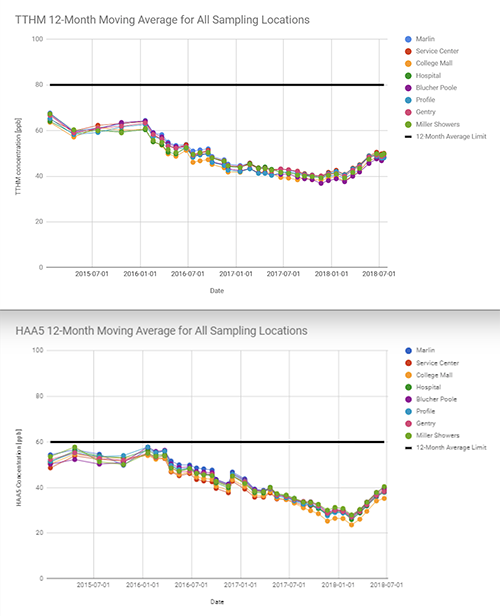Page last updated on August 17, 2018 at 3:05 pm
For more information, please contact
Vic Kelson
Director
City of Bloomington Utilities
[email protected]
812-349-3650
City of Bloomington Officials Report July 2018 Disinfection Byproduct Levels
Bloomington, Ind. - Disinfection byproduct (DBP) test results for July 2018 have been released. Concentrations of DBPs are lower than those recorded the previous month. The annual moving average concentrations continue to be below the maximum levels allowed by state and federal guidelines, and do not indicate that water has posed a health risk during this period. The two DBP categories, haloacetic acid (HAA5) and trihalomethane (TTHM), result from the reaction of chlorine disinfectant with naturally occurring organic material in the source water drawn from Lake Monroe. For July 2018, the measured concentration of HAA5 levels at the eight testing sites ranged from 31 to 38 parts per billion (ppb). Total TTHM levels were between 50.4 ppb and 57.1 ppb. By contrast, June 2018 HAA5 results ranged from 42 to 68 ppb and TTHM, from 58.5 to 84.2 ppb.
“As we anticipated, operational changes that were made in June, combined with the seasonal decline of humic acids in the source water, have resulted in a significant decrease in DBPs for July. The annual moving average concentrations are about the same as last month, and we expect conditions to continue to improve,” said Utilities Director Vic Kelson.
DBPs are affected by many factors, including temperature, precipitation, and sediment in the source water. CBU is monitoring DBPs monthly and has made recent changes at the plant, notably the addition of powdered activated carbon (PAC) and a reduction in the disinfectant feed rate. CBU started adding PAC as a means of removing organic species that lead to taste and odor complaints in summer.
“Utilities staff continue to go above and beyond IDEM and EPA standards to ensure the safety of Bloomington’s drinking water,” said Mayor John Hamilton. “We count on their vigilance and are committed to sharing their reports about this common resource.”
Testing of CBU water is conducted by a private, independent laboratory. All water quality test results are available online at data.bloomington.in.gov under “Utilities.”
###

